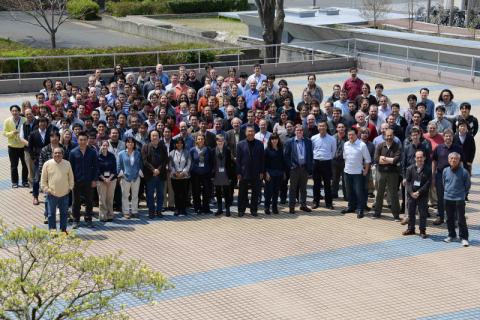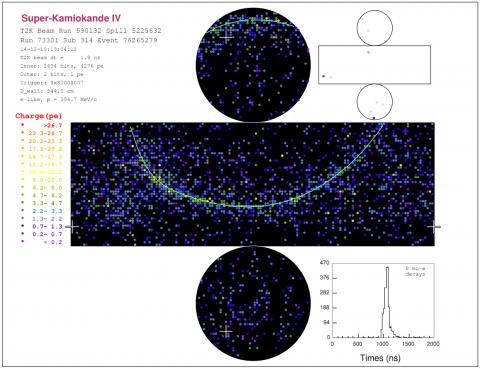

TRIUMF postdoctoral researcher Mark Scott and University of Victoria graduate student Jordan Myslik explain Canada’s contributions to T2K, and describe how the collaboration’s latest results are beginning to hint at an answer for understanding asymmetry in the Universe.
The predominance of matter over antimatter in the universe points directly to the existence of some currently hidden laws of physics. The phenomenon of neutrino oscillations, which involves comparing the fluctuations of neutrinos and antineutrinos, is helping researchers uncover these unknown laws.
Antineutrinos and asymmetry
In its first electron antineutrino appearance search, the T2K collaboration has observed three electron antineutrino candidates in a muon antineutrino beam at the Japan-based Super-Kamiokande detector. The collaboration also observed muon antineutrino disappearance earlier this year. The appearance and disappearance of neutrino and antineutrino flavours is called neutrino oscillation and occurs because of the quantum mechanical interference of neutrino masses and flavours.
The search for electron antineutrino appearance is the next step in the exploration of charge parity (CP) symmetry, which specifies that antimatter should behave just like matter if viewed through a mirror and upside down.
“This is one of the tantalizing mysteries about neutrinos that remains to be solved. If neutrinos violate CP, it could help explain the matter-antimatter asymmetry in the Universe,” explains University of Victoria Graduate Student Jordan Myslik. CP violation in neutrinos would manifest itself as antineutrinos oscillating differently than neutrinos.
T2K’s neutrino mode results gave a first hint that CP might be violated by neutrinos. If that is the case, then the electron antineutrino appearance rates will be suppressed. The current level of statistics are not high enough to be sure. For that, T2K will need to accumulate sufficient data for a large signal.
“Until now, CP violation has only been observed in quarks, but this is not enough to account for the observed matter-antimatter asymmetry of the Universe,” adds TRIUMF Postdoctoral Researcher Mark Scott. If observed, this would be the first time CP violation is spotted outside of the quark sector.
The results
T2K began collecting data in antineutrino mode in May 2014, and completed its first run in antineutrino mode in June 2015. Before this, T2K took data in neutrino mode, 2010 — 2013, and definitively established electron neutrino appearance from a muon neutrino beam. Based on the neutrino mode results, T2K would expect to observe 3.8 events, with 1.8 coming from backgrounds. Although three events are too small to draw firm conclusions, it is a first for T2K with antineutrinos.
These latest events are a clear demonstration of the potential to perform a powerful antineutrino oscillation search. T2K will run again in the autumn and should collect more than twice the data already in hand, which could give enough data to make a significant observation. “These results show that T2K can make world-leading measurements using both neutrinos and antineutrinos, which is needed to search for charge-parity (CP) violation in the neutrino sector,” says Mark.
The collaboration has updated its observation of muon antineutrino disappearance. The collaboration expected to observe 103.6 events, but instead observed just 34. This clear signature of antineutrino disappearance strengthens the collaboration’s already world-best measurement of muon neutrino disappearance.
Canada’s role in T2K
Canada was the first international partner to join the T2K collaboration, which now includes about 500 members from 59 institutes. The T2K-Canada collaboration consists of 40 scientists from eight institutions, including TRIUMF, the University of Victoria, the University of British Columbia, the University of Alberta, the University of Regina, the University of Winnipeg, York University, and the University of Toronto.
“Canada and TRIUMF are very involved with both T2K and this analysis,” explains Mark, who convenes one of the key analysis groups behind the results. Canada has contributed to several parts of the experiment, including beamline monitoring, construction of a new near detector, and analysis and calibration of the SK detector.
Moreover, Canada’s involvement in T2K enables young researchers and students to collaborate on both a national and international scale. Jordan, now using the T2K experiment results as the basis for his PhD thesis, first joined the experiment in his fourth year of undergraduate studies and continued his involvement for the next eight years.
“My formative years as a physicist have occurred in the context of this experiment, from the late design phase, through testing, commissioning, stable operation, to results,“ Jordan says.
“T2K is pushing the boundaries of neutrino physics … the T2K collaboration includes very talented, smart and enthusiastic people, and it is a great opportunity to work with and learn from them,” says Mark. “It's really a fantastic place to do science!”
MSU Professor Kendall Mahn, a former TRIUMF postdoctoral researcher, shared the results at a lecture at Fermilab following the official announcement at the European Physical Society Conference in Vienna this week.
Congratulations to the team on this achievement!
– Prepared by Melissa Baluk, with content from t2k-experiment.org (original article)
Top photo: Members of the T2K collaboration, April 2014.
Bottom photo: A T2K-SK electron antineutrino candidate event display.
